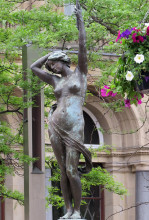
The seeker of public sculpture in Leeds will probably spend more time looking at decorated buildings than statues, but in City Square there is a good collection of civic statuary, encountered by the visitor to the city almost as soon as they leave the station.
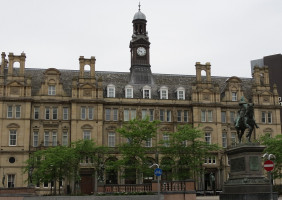 View of the General Post Office, Black Prince statue to right.
View of the General Post Office, Black Prince statue to right.
City Square is not large, has an encroachment of modern and disproportionate buildings, and forms a traffic junction, but a modern redesign has seen an improvement, with a focus on the late 19th Century General Post Office, with a pedestrianised part in front of it and the statues arranged intelligently rather than being scattered as previously. This rearrangement is probably more in line with the intentions of the originator of the decorative scheme for the Square, for all the bronze statues were commissioned at the same time. T. Walter Harding was the visionary Lord Mayor at the time and provided the funds to develop the scheme as well as donating some of the statuary.
The Black Prince, by Thomas Brock, and side panels. 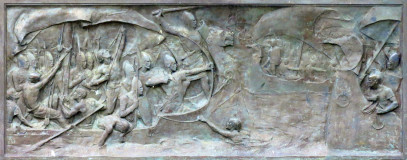
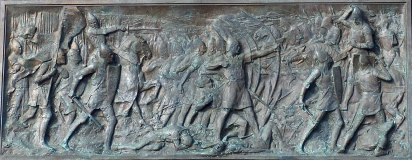
The principal statue is an equestrian one of the Black Prince. A larger than lifesize bronze, the group stands on an elevated plinth, and somewhat forward towards the edge of the pedestrianised space, so that it provides a focus to the Square and will be seen by all passers by. The Black Prince is a dynamic figure, chest outthrust, legs stiffly straight and away from the sides of the horse, one hand on the reins, the other boldly gesturing. The strangeness of the statue is the chainmail descending form the helmet, so that there is no chin or neck visible at all. The stern features of the subject are, however, strong enough to overcome the essential shapelessness which results. The horse is a noble charger, head bent, one foot lifted. On the sides of the plinth are bronze panels depicting complex battle scenes in relief. The sculptor was Thomas Brock, an important artist who was responsible for many public monuments, above all the Queen Victoria Memorial in front of Buckingham Palace. Among all his groups and portrait statues though, I cannot think of another equestrian figure which he made, so the Leeds one would seem to be in that sense unique.
Statues of James Watt and John Harrison, by H. C. Fehr. 
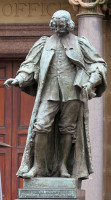
In front of the Post Office are four civic statues in bronze, in two pairs (Watt and Harrison, and Hook and Priestley), each on a short granite plinth, by notable turn of the century sculptors:
James Watt is marginally the oldest statue of the four, being the gift of Richard Wainwright in 1898, though erected with the others in 1903. He is of great seriousness, head bowed, unwinding scroll in one hand, compasses in the other. His clothes are rather debonair, with short flaring cloak, open at the front to reveal his buttoned jacket, a short scarf or cravat swirling across his breast. Henry C. Fehr was the sculptor, whom we shall meet again.
The statue of John Harrison, gift of Councillor Richard Boston in 1903, shows him as a whiskered man with longish hair, slightly Shakespearean, wearing a wide gown over his coat, baggy trousers tucked in to his garters, his sleeves generously proportioned. He carries a book and a handkerchief in one hand, while the other is empty. The sculptor is again H. C. Fehr.
Statues of Dean Hook by F. W. Pomeroy, and Joseph Priestley by Alfred Drury. 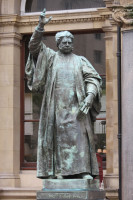

The statue of Dean Hook, Vicar and Bishop of Leeds, gift of T. Walter Harding, 1903, shows the preacher with one arm dramatically raised in the act of preaching. His other hand holds a book, two fingers inserted as bookmarks, but he gazes straight forward, not needing to glance at his text. His garb is a long robe hiding his body, with a dramatic loop of drapery forming the sleeve of his raised arm. F. W. Pomeroy was the sculptor of this work. Although best known for his allegorical figures, including four mighty figures for Lambeth Bridge, Pomeroy carried out a number of commissions for portrait sculpture, including several ecclesiastics.
Finally, the statue of Joseph Priestley shows the scientist as a slender aesthete, poised slightly contrapuncto, examining the contents of a small pestle and mortar in one hand, a magnifying glass in the other. This statue was again the gift of T. Walter Harding and emplaced in 1903, though made in 1899. The sculptor was Alfred Drury, who also made the beautiful statue of Circe in the city, hopefully soon to be returned to Park Square, and the statues described below.
Views of the lamp carriers, Morn and Even, by Alfred Drury.
Around the periphery of the pedestrianised area, then, are arranged eight statues of girls carrying lamps, also by Alfred Drury, four each in two poses, Morning and Evening (or ‘Morn’ and ‘Even’ as the sculptor described them). Morning carries a bunch of roses clutched to her body, while Evening has her free hand on her head, which is bowed and with the eyes already closed. The figures are almost nude, with the merest wisp of light drapery swirling around the body, and are ideal in an Edwardian fashion, full in the figure, more rounded and softly feminine than they might have been a couple of decades previously, very beautiful and very characteristic of Drury. These are key works of art nouveau sculpture in England, and Leeds is privileged to have them. In the words of Spielman, an important critic of the time, ‘[Drury]… designed the colossal gure exhibited at the Royal Academy in 1898 under the title of ‘Even’, so that a set of standards, unique in England, might light the square like the figures that decorate the pillars round the Paris Opera House.’
Terra cotta and stone figures on Leeds' General Post Office building.
The grand General Post Office, now converted to a hotel, is the design of the architect Henry Tanner, and dates from 1896 - see picture near the top of this page. There are eight statues on the frontage – four in stone above the sides of the two entrances, and four more, terra cotta, in a row at third storey level. The Pevsner Guide to Leeds ascribes the entrance statues to the architectural sculptor and teacher W. S. Frith, but I am not clear on the basis for the attribution. The stone figures, slender girls in long drapes, with short or tied back hair in an end-of-the-century fashion, are somewhat worn, and although two at least appear to be reading and writing, and one carries a scroll, the other holds some item so damaged as to be obscure. The Pevsner guide refers to forms of communication’, and to ‘figures of Art and Science’, which could only partially describe the terra cotta figures, as they are all science-related. One holds a coil of wire attached to some measuring device, perhaps an early voltmeter; a second holds the regulator from a steam engine; the third has a torch with some slender tool which might be a wire, indicating electric light, or be a taper or some tube to deliver gases into the flame; and the fourth is a conventional figure of Geometry with set square and scroll. The drapes and poses of these figures are fair, but the faces, which would not of course be seen so clearly from a distance below, are bland. The stone figures below, worn and greened and blackened by lichen and pollution as they are, are of superior quality.
Also in the Square, we should note a rather good church, Gothic in Perpendicular mode and from early Victorian times, by the architects Bowman and Crowther. It has a variety of satisfying details, including figure sculpture in niches, and small gargoyles and little blocky monsters in relief. There is no tower, because this is the Mill Hill Unitarian Chapel. There is sculptural work within, including from the previous church on the site, where Joseph Priestley (whose statue we noted above) was a minister, but I have not seen the interior.
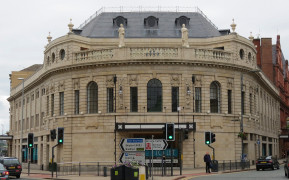
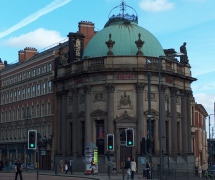 Leeds' Majestic Cinema, and Yorkshire District Bank.
Leeds' Majestic Cinema, and Yorkshire District Bank.
Other buildings in the Square are an eclectic mix of post-1900 buildings through to the very modern. Two of them are worth noting on these pages. To the left of the General Post Office as we look at it, on the sharp corner between Quebec Street and Wellington Street, is a nicely curved classical building which was once the Majestic Cinema, with balustrade and pots with a mansard roof behind. Two vertical panels towards the corner have carved musical instruments. Directly above these, perched on the balustrade, are a pair of bright white statues of standing girls, one holding a book, the other a stringed musical instrument. Presumably of modern date. The cinema itself, by the architect Pascal Stienlet, was put up in 1921.
Finally, in the sense that City Square is not square, so that we can count as part of it the extension towards the railway station, there is the building on the corner of Boar Lane and Bishopsgate Street, the domed Yorkshire District Bank. The entrance is on the corner facing the Square, and the building curves back on either side, with a fine colonnade of tall Corinthian columns with windows between; above them is half a blank storey with sculptured panels, and above that, a balustrade, with free standing pots and a sculptural group facing each of the principal sides, with behind, the dome. An excellent thing, the creation of the architect W. W. Gwyther, and dating from 1899. Joseph Thewlis was apparently the creator of the panels, but whether he also sculpted the figures I do not know. The group on the Bishopsgate Street side, thus towards the station, is an allegorical figure of Industry, consisting of a sturdy workman, dressed in a classical tunic, and bearded in the manner of Trajan. On the one side, he has an anvil, and on the other stands a large bird, perhaps an eagle. For other statues of Industry, see this page.
The group towards Boar Lane is emblematic of Agriculture – a classical girl in a graceful robe, carrying a sickle and sheaf of corn. Beside her is a boy or cherub, unclothed, pushing an agricultural implement – an ancient plough, I think – and on the other side, a small sheep sits placidly. For more allegorical statues of Agriculture, see this page.
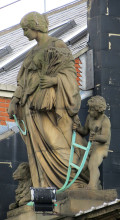
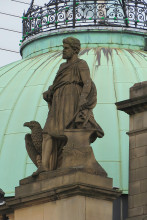 Stone groups of Agriculture and Industry for Yorkshire District Bank.
Stone groups of Agriculture and Industry for Yorkshire District Bank.
Leeds Town Hall // A Leeds decorated building - 26 Park Row
Architect Cuthbert Brodrick of Hull and Leeds // Sculptor James Thewlis of Leeds
Sculpture in English towns // Sculpture pages
Visits to this page from 13 Mar 2014: 2,000